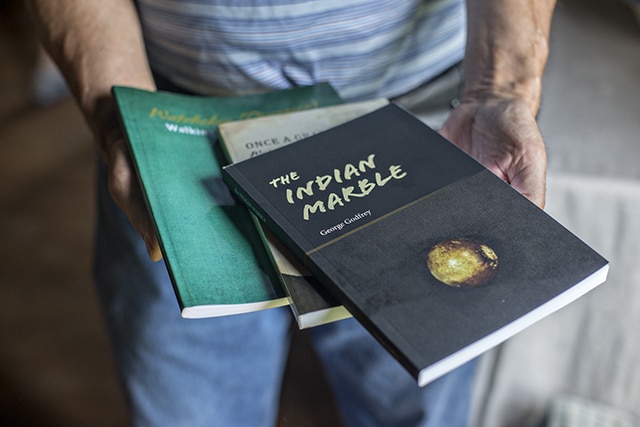
The nineteenth century was a time of innovation but also continued hardship. Relics and history from this era can easily be lost and forgotten due to neglect. Yet it has been proven that if someone is determined and willing to put in the time and effort, the mysteries of the past can become a reality. Bergeron-family descendant George Godfrey is one such person, having dedicated the last 25 years of his life to researching the history of the Potawatomi people.
Born in Shawnee, Okla., Godfrey moved frequently between South Dakota, Arizona and Nebraska with his parents as a child. Godfrey’s father worked for the Bureau of Indian Affairs and introduced him to numerous Native American cultures.
Godfrey graduated with a bachelor’s degree in in Biology from Northern State University in Aberdeen, S.D. From there he continued his education earning his PhD. in Entomology at Cornell University. His success in school led him to his first career researching Lepidoptera at the University of Illinois at Urbana-Champaign. Godfrey’s work there led him to his next post as a professor at Haskell Indian Nations University in Lawrence, Kan. where he became the Vice President for Academic Affairs. He later moved to Washington D.C. as a national program leader for grant programs at tribal colleges.
During his lengthy career in academics, Godfrey found himself longing to research his past and reconnect with family members that he had not seen in years.
 “Something about my family’s past always intrigued me,” said Godfrey. “At a CPN regional meeting I started to network and begin learning about the history of my family. The stories and stuff I was finding out lead me into my first book.”
“Something about my family’s past always intrigued me,” said Godfrey. “At a CPN regional meeting I started to network and begin learning about the history of my family. The stories and stuff I was finding out lead me into my first book.”
The book, “Watchekee (Overseer) Walking in Two Cultures,” is a historical depiction of Godfrey’s great-great-grandmother through oral histories and various historical sources.
“I’m still finding out new things and history has proven it can lead you to dead ends,” said Godfrey. “Trying to fill those blank spots from the mysterious history of my great-great grandmother led me into writing a historically fictional account based off of the facts I have gathered while archiving her history.”
“Once a Grass Widow: Watchekee’s Destiny,” is Godfrey’s portrayal of his great-great grandmother’s past and how her life was described through his discoveries.
A consequence of writing the two books was the emergence of old stories told by other members of his family. As a result, Godfrey penned his most recent work, a book about his great-grandfather.
“The Indian Marble,” is a historically fictional story inspired by a marble that once belonged to his great-grandfather John Baptiste Bergeron. “Bat” as he was called, was one of Watchekee’s children who flitted in and out of his family’s life with mysterious appearances and absences. The story takes its reader on a roller-coaster ride of a journey throughout the United States and Mexico depicting the odd life his great-grandfather seemed to live.

Godfrey continues to learn about his family history and the Potawatomi nation. He lives on the outskirts of Athens, Ill. with his wife Pat and is the president of the Potawatomi Trail of Death Association. He is currently working on two more books to add to the collection that he has written. The first is a science fiction novel called “Cheyenne Oil” and the other is another work of historical fiction titled, “The Removal” which is based off of the forced removals of the Potawatomi in the mid 1830’s.
“Throughout my time researching the history of my family and CPN I’m still amazed at how fascinating it is to find out new things,” said Godfrey. “It can be discouraging when you run into dead ends but the feeling you get when you find something out about your family’s past is something that can’t be explained. I encourage anyone interested in finding out more about their heritage to dig in and start researching. You’ll never know what you may find.”
For more information about George please visit www.potawatomi-tda.org or email him at pnginnthewoods@gmail.com.
